- Home
- About Us
- Industry
- Services
- Reading
- Contact Us
Solar Carport Market: Current Analysis and Forecast (2023-2030)
Emphasis on Type (T-Shape and Cantilever); Application (Residential, Commercial, and Others); Region/Country.
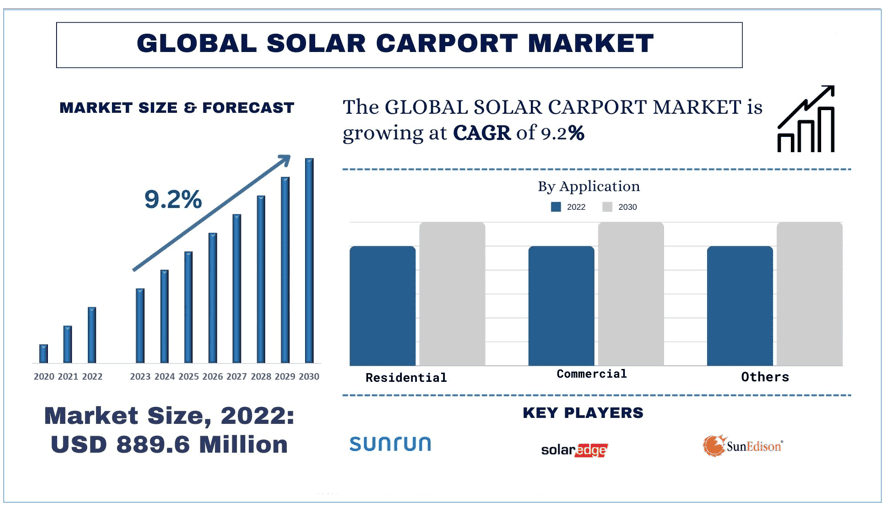
Solar Carport Size & Forecast
The Solar Carport was valued at USD 889.6 Million and is expected to grow at a strong CAGR of around 9.2% during the forecast period (2023-2030) owing to rising investment in renewable energy.
Solar Carport Analysis
By utilizing underutilized space for solar energy production, these structures maximize the efficiency of land use and promote a greener future. Overall, solar carports represent a smart and eco-friendly investment that combines functionality, sustainability, and energy efficiency in a single innovative solution. The market dynamics are influenced by various factors, including increasing solar panel installations globally, government initiatives promoting solar energy adoption, and the growing demand for electric vehicle charging stations.
Countries all around the world are heavily investing in renewable energy in order to meet their renewable energy targets and the solar energy market is one of the prominent sources of energy which has seen a massive boom in the last decade. For instance, In the USA, one of the leading nations for solar power, In the last decade alone, solar has experienced an average annual growth rate of 33%. Thanks to strong federal policies like the Solar Investment Tax Credit, rapidly declining costs, and increasing demand across the private and public sectors for clean electricity, there are now more than 140 gigawatts of solar capacity installed nationwide, enough to power 25 million homes.
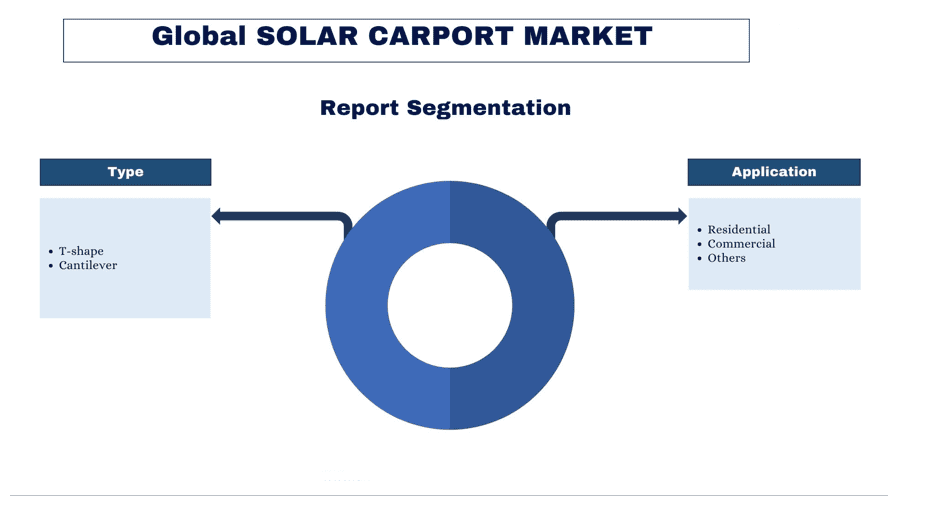
Solar Carport Trends
This section discusses the key market trends that are influencing the various segments of the Solar Carport as identified by our team of research experts.
Commercial Solar Carport Industry
The Commercial segment acquired a majority share in the Solar Carport market and is expected to showcase a substantial growth rate during the forecast period. Commercial solar carports constitute a huge development for outdoor parking areas of commercial and industrial structures. Shopping centers, educational institutions, supermarkets, corporate buildings, and EV charging stations all over the world are predicted to install solar carports during the coming years. Moreover, commercial solar carports provide benefits such as enhanced parking experience for employees and customers, along with free advertising carriers. It boosts the company’s green credentials. The numerous advantages of solar carports and rising sanctions on companies to reduce carbon emissions are expected to improve the segment’s growth.
APAC is Expected to Grow with Significant CAGR During Forecast Period
APAC registered the highest market share in the Solar Carport market and is expected to witness an influential CAGR in the forecasted period. This is mainly owing to many Solar carport projects taking place in China, India, Australia, and Japan. Moreover, favorable government policies, regulations, and investments in achieving renewable energy targets set by various countries are driving the market. For instance: In Australia, the Australian government will provide AUD 14 million to support 5B’s AUD 33.4 million strategic technology innovation project through the Australian Renewable Energy Agency; In Japan, the Japanese government allocated 8 billion yen in the 2021 national budget to support the introduction of independent solar power generation equipment and storage batteries including electric vehicles through on-site PPA; and in India, the Government of India announced an additional capital infusion of Rs. 10 billion to the Solar Energy Corporation of India and Rs.15 billion to the Indian Renewable Energy Development Agency.
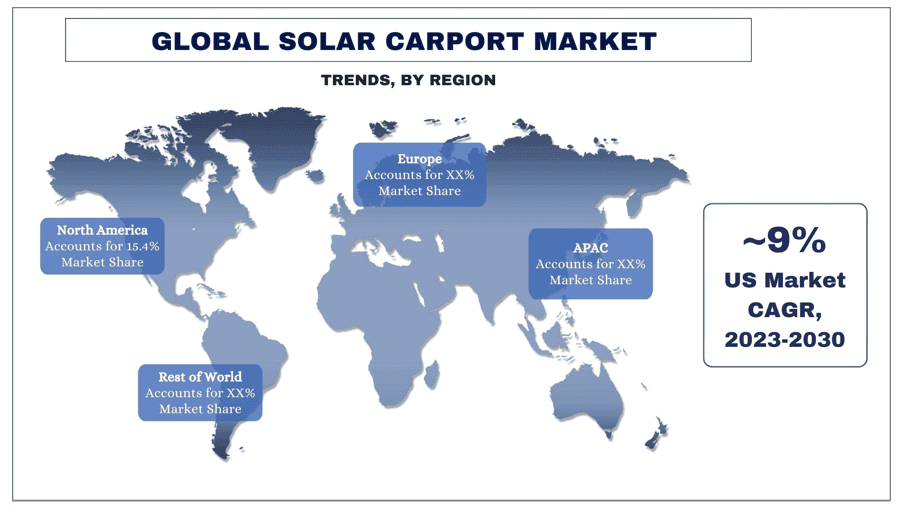
Hydropower Industry Overview
The Solar Carport is competitive and fragmented, with the presence of several global and international market players. The key players are adopting different growth strategies to enhance their market presence, such as partnerships, agreements, collaborations, new product launches, geographical expansions, and mergers and acquisitions. Some of the major players operating in the market are SunPower Corporation, Palmetto, Sunrun, SolarEdge, Orion Carport, Baja Carports, Solar Carports Direct, Quest Renewables, Inc., SunEdison., and Envision Solar.
Solar Carport News
- In June 2023 – SolarEdge announces a new Bi-Directional DC EV Charger at Intersolar 2023. The charger, designed for efficient, high-powered charging, also promotes home energy storage via electric vehicle (EV) batteries.
- In June 2023 – Samsung announced that it has partnered with SolarEdge to promote Net Zero Home. Net Zero Home is Samsung’s initiative which aims to help develop spaces that produce, store, manage, and consume energy without creating energy surplus or shortage
Solar Carport Market Report Coverage
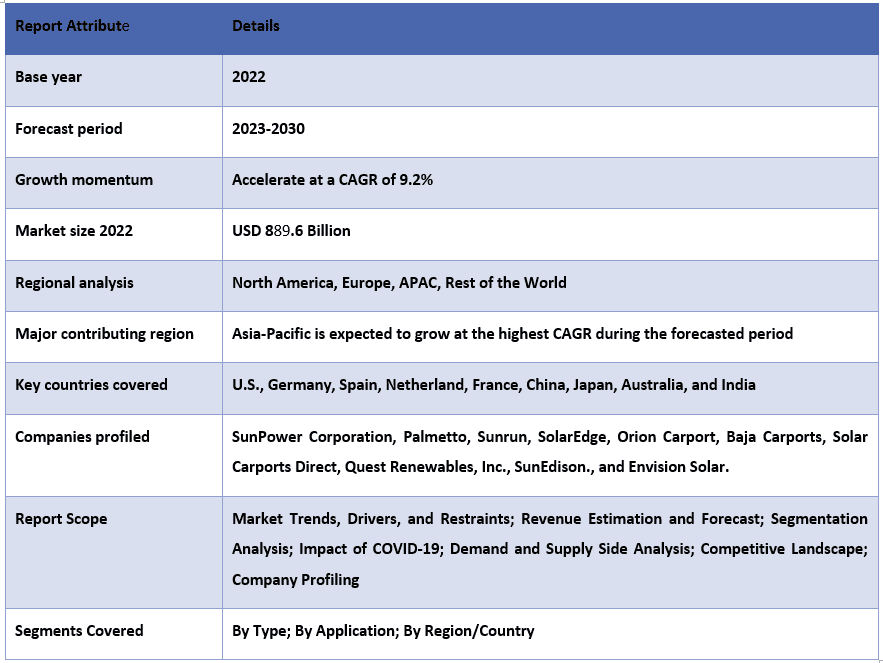
Reasons to buy this report:
- The study includes market sizing and forecasting analysis validated by authenticated key industry experts.
- The report presents a quick review of overall industry performance at one glance.
- The report covers an in-depth analysis of prominent industry peers with a primary focus on key business financials, product portfolios, expansion strategies, and recent developments.
- Detailed examination of drivers, restraints, key trends, and opportunities prevailing in the industry.
- The study comprehensively covers the market across different segments.
- Deep dive regional level analysis of the industry.
Customization Options:
The global Solar Carport can further be customized as per the requirement or any other market segment. Besides this, UMI understands that you may have your own business needs, hence feel free to connect with us to get a report that completely suits your requirements.
Table of Content
Research Methodology for the Solar Carport Analysis (2023-2030)
Analyzing the historical market, estimating the current market, and forecasting the future market of the global Solar Carport were the three major steps undertaken to create and analyze the adoption of Hydropower in major regions globally. Exhaustive secondary research was conducted to collect the historical market numbers and estimate the current market size. Secondly, to validate these insights, numerous findings and assumptions were taken into consideration. Moreover, exhaustive primary interviews were also conducted, with industry experts across the value chain of the global Solar Carport. Post assumption and validation of market numbers through primary interviews, we employed a top-down/bottom-up approach to forecasting the complete market size. Thereafter, market breakdown and data triangulation methods were adopted to estimate and analyze the market size of segments and sub-segments of the industry pertains to. Detailed methodology is explained below:
Analysis of Historical Market Size
Step 1: In-Depth Study of Secondary Sources:
Detail secondary study was conducted to obtain the historical market size of the Solar Carport through company internal sources such as annual reports & financial statements, performance presentations, press releases, etc., and external sources including journals, news & articles, government publications, competitor publications, sector reports, third-party database, and other credible publications.
Step 2: Market Segmentation:
After obtaining the historical market size of the Solar Carport, we conducted a detailed secondary analysis to gather historical market insights and share for different segments & sub-segments for major regions. Major segments are included in the report as Type, and Application. Further country-level analyses were conducted to evaluate the overall adoption of testing models in that region.
Step 3: Factor Analysis:
After acquiring the historical market size of different segments and sub-segments, we conducted a detailed factor analysis to estimate the current market size of the Solar Carport. Further, we conducted factor analysis using dependent and independent variables such as Type, and Application of the Solar Carport. A thorough analysis was conducted for demand and supply-side scenarios considering top partnerships, mergers and acquisitions, business expansion, and product launches in the Solar Carport sector across the globe.
Current Market Size Estimate & Forecast
Current Market Sizing: Based on actionable insights from the above 3 steps, we arrived at the current market size, key players in the global Solar Carport, and market shares of the segments. All the required percentage shares split, and market breakdowns were determined using the above-mentioned secondary approach and were verified through primary interviews.
Estimation & Forecasting: For market estimation and forecast, weights were assigned to different factors including drivers & trends, restraints, and opportunities available for the stakeholders. After analyzing these factors, relevant forecasting techniques i.e., the top-down/bottom-up approach were applied to arrive at the market forecast for 2030 for different segments and sub-segments across the major markets globally. The research methodology adopted to estimate the market size encompasses:
- The industry’s market size, in terms of revenue (USD) and the adoption rate of the Solar Carport across the major markets domestically
- All percentage shares, splits, and breakdowns of market segments and sub-segments
- Key players in the global Solar Carport in terms of products offered. Also, the growth strategies adopted by these players to compete in the fast-growing market
Market Size and Share Validation
Primary Research: In-depth interviews were conducted with the Key Opinion Leaders (KOLs) including Top Level Executives (CXO/VPs, Sales Head, Marketing Head, Operational Head, Regional Head, Country Head, etc.) across major regions. Primary research findings were then summarized, and statistical analysis was performed to prove the stated hypothesis. Inputs from primary research were consolidated with secondary findings, hence turning information into actionable insights.
Split of Primary Participants in Different Regions
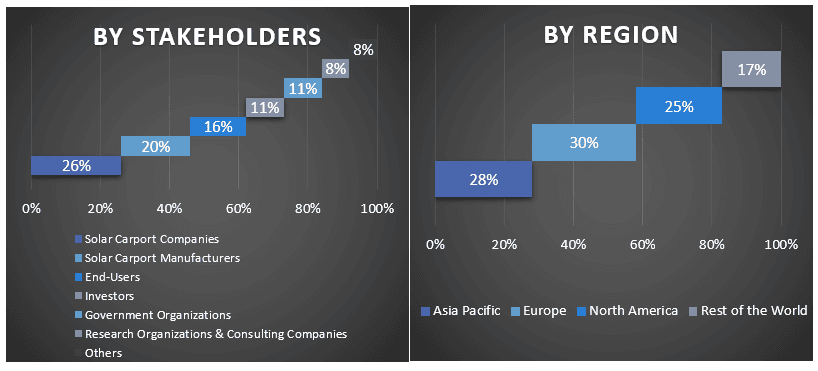
Market Engineering
The data triangulation technique was employed to complete the overall market estimation and to arrive at precise statistical numbers for each segment and sub-segment of the global Solar Carport. data was split into several segments & sub-segments post studying various parameters and trends in the areas of Type, and Application in the global Solar Carport.
The main objective of the Global Solar Carport Study
The current & future market trends of the global Solar Carport were pinpointed in the study. Investors can gain strategic insights to base their discretion for investments on the qualitative and quantitative analysis performed in the study. Current and future market trends determined the overall attractiveness of the market at a regional level, providing a platform for the industrial participant to exploit the untapped market to benefit from a first-mover advantage. Other quantitative goals of the studies include:
- Analyze the current and forecast market size of the Solar Carport in terms of value (USD). Also, analyze the current and forecast market size of different segments and sub-segments
- Segments in the study include areas of Type, and Application
- Define and analysis of the regulatory framework for the Hydropower industry
- Analyze the value chain involved with the presence of various intermediaries, along with analyzing customer and competitor behaviors of the industry
- Analyze the current and forecast market size of the Solar Carport for the major region
- Major countries of regions studied in the report include Asia Pacific, Europe, North America, and the Rest of the World
- Company profiles of the Solar Carport and the growth strategies adopted by the market players to sustain in the fast-growing market
- Deep dive regional level analysis of the industry
Frequently Asked Questions FAQs
Q1: What is the current market size and growth potential of the Solar Carport?
Q2: What are the driving factors for the growth of the Solar Carport?
Q3: Which segment has the largest share of the Solar Carport by Type?
Q4: What are the emerging technologies and trends in the Solar Carport?
Q5: Which region will dominate the Solar Carport?
Related Reports
Customers who bought this item also bought










